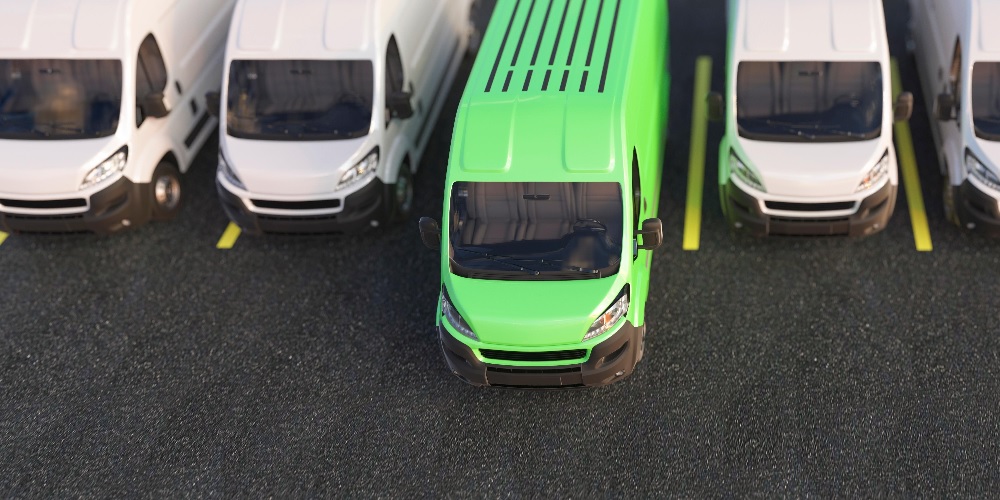Transition toward a net-zero emissions for state and local entities

It’s no secret that state and local fleets across North America are headed for a net-zero future. In 2022, the U.S. and Canadian governments joined seventeen other countries in pursuit of net-zero emissions by 2050.
This lofty goal requires the cooperation of state and local entities, notably hard-working fleet managers dedicated to improving their communities. But although you may be willing to join this developing cause, you may not feel equipped to take the next steps on your own.
This guide explains how you can build a net-zero emissions strategy that accounts for your organization’s needs and expectations.
The benefits of transitioning to net-zero emissions
What does your organization stand to gain from net-zero emissions? Would greening your fleet have any impact on nationwide carbon emissions?
Let’s take a look at the facts.
1. Carbon releases
The first and most obvious benefit of net-zero emissions is reducing the carbon released into the atmosphere. EVs emit far less per year compared with traditional fuel. Researchers suggest that the average EV nearly halves total emissions, though more advanced vehicles provide even greater benefits.
The exact numbers are:
- Gasoline: 11,400 pounds of emissions per year
- Hybrid: 6,300 pounds of emissions per year
- Plug-in hybrid: 5,800 pounds of emissions per year
- All electric: 3,900 pounds of emissions per year
2. Public health and stewardship
The less carbon enters the atmosphere, the better public health becomes. Studies show that reducing carbon emissions on municipal highways could:
- Decrease nitrogen dioxide and black carbon exposures by 9% and 11%
- Save 1,310 years of life (YLL) cost annually
- Equate to $428 million in social benefits
3. Environmental and social benefits
Even outside of EVs, the right management software can help you reach net-zero emissions. With telematics, organizations can make a measurable impact, including:
- Reduced fuel use: 57%
- Reduced CO2 emissions: 46%
- Improved driver safety and satisfaction: 46%
- Reduced idling: 43%
- Meeting compliance requirements: 43%
Whether you manage three vehicles or a fleet of 300, a net-zero future could have a powerful impact on your agency and the public that it serves.
How governments can transition to net-zero emissions
If you’re ready to start transitioning your fleet to cleaner, greener transportation, you can use this guide to begin planning for next steps, new infrastructure, and more.
You should start with the most vital consideration.
Building a succession plan
It’s likely that most of your government fleet runs on traditional fuel. For this reason, it’s a good idea to build a succession plan for phasing out existing vehicles for newer, greener models.
Over 69% of fleet managers say that building their sustainability plans with good data helped them reduce operating costs. You may want to integrate your fleet with telematics to help you make more informed decisions.
Designing EV infrastructure
One in two fleet operators (or 50%) say that incorporating EV charging stations is one of the biggest challenges faced by their fleet. Sitting down to design a development path is a great way to prepare without getting too overwhelmed.
As you design your local charging infrastructure, be sure to plan for:
- The right charging station locations
- Plug-in charger types (level one, level two, or DC fast chargers)
- Networked or non-networked
Partnering with local utilities
Local utility companies, especially public and private energy producers, are essential for acquiring more sustainable electric solutions. As you prepare to migrate toward a zero-emissions future, you may want to speak to your local electrical utility about:
- Smart grid technologies
- Renewable energy integration
- Location or placement strategy
Constructing the system
If you don’t know your baseline, you don’t know your outcomes. It’s pivotal to choose metrics by which you can measure your progress toward a zero-emissions future.
To do this, most fleet managers measure:
- Fuel consumption: 80% of respondents
- Operating costs: 58% of respondents
- Vehicle miles traveled: 56% of respondents
- Idling time: 56% of respondents
- Vehicle life and use: 53% of respondents
Purchasing EVs
With the heavier legwork behind you, it’s time to choose the right EVs for your organization. You can pick between:
- Battery Electric Vehicles (BEVs)
- Plug-In Hybrid Electric Vehicles (PHEVs)
- Fuel Cell Electric Vehicles (FCEVs)
Keep in mind that reaching net-zero emissions is more of a journey than a destination. Even with your greening plan finalized and actualized, you need to keep an eye on implementation so you can identify areas to optimize in the future.
Municipal resources for net-zero transitions
As a state or local entity working to reduce your carbon footprint, you’ll need to partner with third-party entities to maximize your transition.
The most notable cooperatives for forward-thinking agencies include:
- Climate Mayors: A group of 750 mayors representing 48 states and 60 million Americans
- The Electrification Coalition: A team of North American EV experts working to reduce adoption barriers for EV infrastructure
- Sourcewell: A government organization serving other government organizations with competitively sourced cooperative contracts
Becoming a participating agency with Sourcewell allows you to browse contracts and download resources at no extra cost.
See how easy it is to smoothly adhere to any greening initiatives using Sourcewell’s cooperative purchasing program. Streamline the process by choosing from hundreds of suppliers already on contract. Sourcewell’s procurement experts competitively solicit and award contracts on behalf of 50,000 participating agencies in North America. Check out our contracts here.


